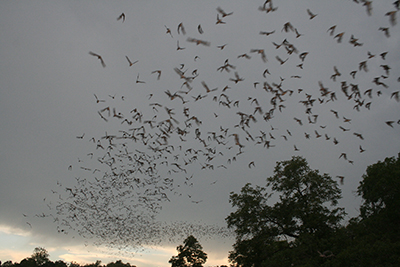Vaccines are Key: Protect Your Pet from Rabies

Rabies is a deadly disease that can harm pets, wildlife, and people. Luckily, thanks to modern medicine, it is also easily preventable through vaccinations and responsible pet ownership.
Dr. Katie McCool, a clinical assistant professor at the Texas A&M College of Veterinary Medicine & Biomedical Sciences, discusses the most common signs of rabies and what to do if you or a pet is bitten by a rabid animal.
“Rabies is a virus that is spread through contact with the saliva of infected animals, most commonly through a bite from the infected animal,” McCool said. “In rare cases, rabies also can be spread when infected saliva gets into an open wound or the mucous membranes, such as the mouth or eyes.”
Rabies can spread to any mammals, including humans, but not to birds, fish, reptiles, or amphibians. The virus is diagnosed in cats more than any other domestic animal, but it is most commonly seen in wild animals like bats, raccoons, skunks, coyotes, and foxes.
Rabies is exhibited through both behavioral and physical changes in an animal, including fearfulness, aggression, excessive drooling, difficulty swallowing, difficulty walking, and seizures.
Wild animals that have contracted rabies often approach humans without fear and are seen wandering around in the daytime, even if they are normally nocturnal. Animals showing these behaviors should be avoided and reported to a local animal control department as soon as possible.
“We only rarely see rabies cases at the Texas A&M Small Animal Hospital, which is good news because rabies is a fatal disease once animals start to show signs of infection,” McCool said. “However, this disease is definitely present in our area; there are reports of rabies in our county every year, though these reports are primarily wildlife, such as skunks and bats.”
She recommends visiting the Texas Department of State Health Services webpage on rabies for more information on cases by county in Texas or the equivalent site for other states.
While there is no treatment for rabies, the disease is completely preventable with vaccines. Dogs, cats, ferrets, horses, and livestock can all be vaccinated against the rabies virus.
“Your veterinarian is an excellent source of information about keeping your pets safe from rabies,” McCool said.
“Owners can also decrease the risk of exposure to rabies by limiting your pets’ contact with unvaccinated animals,” she said. “Keep cats and ferrets indoors and do not let your dogs roam free.”
If a pet is bitten by a wild or unknown animal, contact both a veterinarian and local animal control authorities immediately. The pet will need to be revaccinated for rabies, kept under quarantine, and observed for a specific period of time, depending on state and city laws.
If you or another person is bitten by a suspected rabid animal, clean the wound with soap and a disinfectant for at least 15 minutes. Contact a doctor for medical advice and report the bite to the local health department.
McCool recommends visiting the AVMA website “Rabies and Your Pet” for more information.
Vaccinations are one of the easiest ways to protect a dog, cat, or other pet from rabies, while also reducing the transmission of a deadly disease that can harm wildlife and people as well. Vaccination is a key part of responsible pet ownership and can help ensure your animal lives a long and healthy life.
Pet Talk is a service of the College of Veterinary Medicine & Biomedical Sciences, Texas A&M University. Stories can be viewed on the web at vetmed.tamu.edu/news/pet-talk. Suggestions for future topics may be directed to editor@cvm.tamu.edu.


